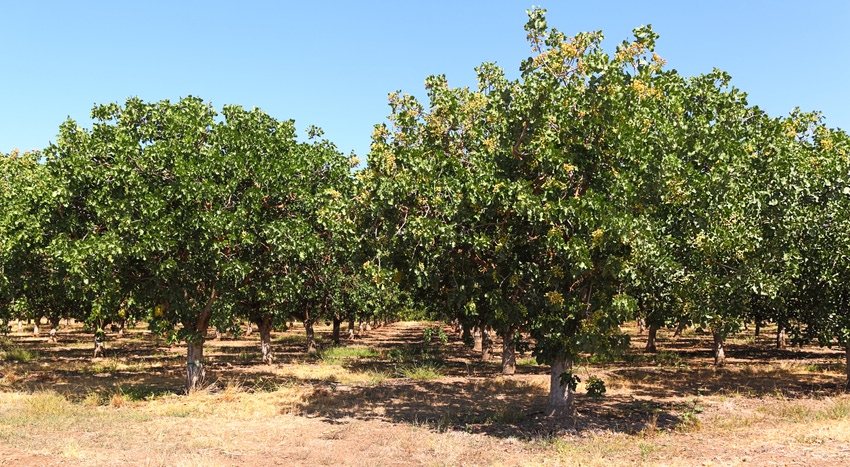
The expansion of California pistachio acreage into “trickier” soils means a higher level of management to maximize nut production.
There are areas on the West Side of the San Joaquin Valley where planted pistachio trees are presenting challenges to growers and managers, says Daniele Zaccaria, assistant University of California (UC) Cooperative Extension (UCCE) specialist who focuses in agricultural water management and irrigation.
Much of this former cotton ground, he says, has higher salt concentration, noting that infiltration rates and salt levels can vary across individual planting sites.
Zaccaria and other researchers have monitored the effects of salinity on tree health and productivity in the Hanford and Lemoore areas of Kings County.
High saline conditions can make it more difficult to accurately determine evapotranspiration, or ET, to schedule irrigations, he explains. Tree growth when high salts are present can reduce canopy size, affecting ET calculations.
Among the effects of salinity damage are osmotic effects where ions in soil-applied water increase the soil’s ability to retain water, leaving less water available to plants and specific ions which directly damage plants. Tree sensitivity increases with time which can impact trunk and root storage.
Osmotic effects dominate early. Specific ion damage is more likely in older trees.
Here’s what’s known about pistachio salinity tolerance:
Trees are tolerant to ECe (electrical conductivity of soil) to up to 8.4 dS/m-a measurement of salinity;
There is evidence of osmotic adjustment by trees via ion uptake;
Rootstocks differ in their salinity tolerance;
More sensitivity to salts exists during vegetative growth; and
Trees are more tolerant later in the season.
Salinity management guidelines recommended by UCCE pomologist Louise Ferguson start with a pre-plant soil and water analysis. She says remediation options should be considered if the combination is higher than 6 dS/m.
The first step is to determine if a high reading is due to sodicity (when water is dominated by sodium) or salinity (when salt concentration in soil water is high enough to affect production) or both.
Sodicity should be addressed first, says Ferguson. Gypsum applications and winter leaching can reduce sodicity. Improving infiltration rates and pushing salts below the root zone can improve growing conditions.
Salinity can be reduced by winter leaching or higher amounts of irrigation during the growing season. The recommendation is 100 percent of ET, plus 33 percent more water.
Rootstock choices can impact tree growth and production in higher saline conditions. Ferguson recommends hybrid rootstocks developed for salinity tolerance. Some rootstocks adapt better than others to specific conditions.
More information on specific rootstocks for saline conditions can be found on the UC Davis Fruit and Nut Center website.
At the production stage of tree growth, the leaf, soil, and water sodium levels should be assessed in this order. If leaves show higher levels of salts, gypsum applications or leaching should be considered.
Ferguson notes that boron is not considered toxic until levels reach 1,300 parts per million in an August leaf sample.
Allowing the soil to dry out between irrigations should be avoided in high saline conditions. The impact of high EC in pistachio is more apparent during drought, she notes. Higher rainfall this year should have a positive impact on salinity. Surface water use will also help.
The California Pistachio Research Board is funding ongoing studies on salt tolerance and its effects on pistachio tree health and production.
Growers interested in learning more about saline conditions in pistachio production should consider attending the UC pistachio short course, Nov. 14-16 in Visalia, Calif.
About the Author(s)
You May Also Like




